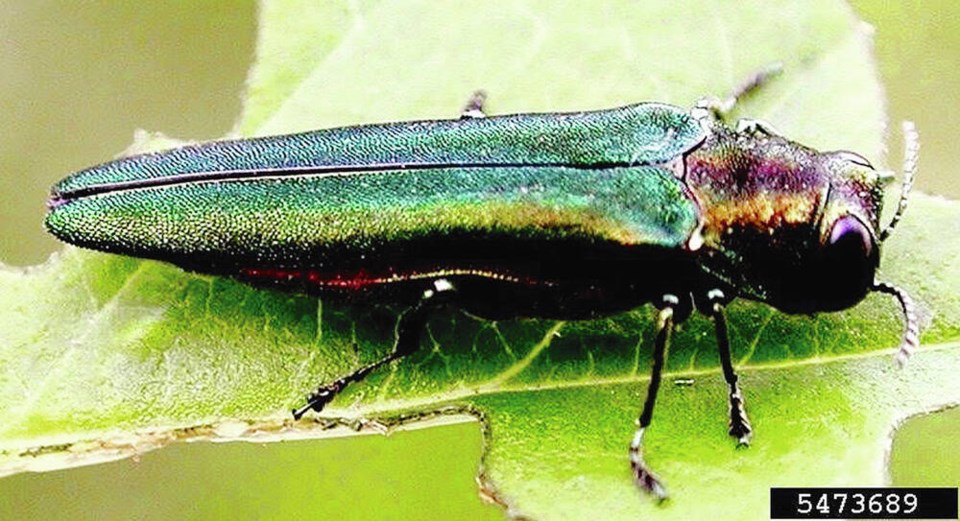With campfires banned across all of B.C. except Haida Gwaii, there’s no reason to bring firewood to or transport it within the province.
The current ban not only helps limit new human-caused wildfires from starting, it lessens the likelihood of tree-killing pests being introduced from one community or region to others.
As reported here last month, the Canadian Food Inspection Agency updated its regulated areas for emerald ash borer to include Vancouver to slow the invasive forest insect’s spread.
With the update, it became illegal to move logs, branches and woodchips from ash trees, as well as firewood from all tree species from Vancouver, including UBC and the University Endowment Lands, without the CFIA’s permission.
The CFIA is the federal agency responsible for keeping Canada’s forests free of invasive non-native pests. This spring, CFIA officials found larvae of the jewel-green beetle in Vancouver.
The presence of the wood-boring larvae, which hatch from eggs laid by the beetles in cracks in the bark of ash trees, indicates the beetle was moved to Vancouver from an area already infested by the tree-killing insect.
Now the CFIA, and others, wants to prevent the insect’s spread within B.C.
Bans on moving firewood already exist in Canada and at the Canada-U.S. border to keep Dutch elm disease, spongy moth, hemlock woolly adelgid and other ecologically and economically devastating pests and diseases from spreading.
In Canada, moving firewood from places where regulated pests have been found comes with penalties of up to $50,000 and prosecution.
Native to colder parts of East Asia, emerald ash borer likely arrived in eastern North America in the early 1990s by hitching a ride on imported, untreated, wood-packing material. It was first identified in Canada in 2002 and is now found in six provinces. It has also been found in the U.S. as far west as Colorado, as well as in Oregon.
North America’s native ash trees have no defences against the beetle, with 99 per cent of trees dying within one to three years of infestation.
The Oregon ash is the only species of ash native to B.C. Two natural stands of the tree remain in the province — one in the Alberni Valley and one on the Saanich Peninsula.
Because ash is not a commonly found species in B.C. forests and because emerald ash borer is able to fly only about 10 kilometres per year, the beetle has no hosts outside of urban areas to help it spread around the province on its own steam.
That means it came to Vancouver because somebody brought it — most likely within firewood.
Although ash isn’t widespread in B.C. forests, it is planted in our cities and towns. The costs of containing and eliminating the current B.C. infestation will fall mainly on the City of Vancouver and its property-owner residents. If the beetle spreads beyond Vancouver, other municipalities and property owners will be required to turn out their pockets.
Removing an infested tree can cost more than $1,000, depending on size, location and other factors, with added costs for its regulated disposal, and more again to replace the tree. There’s a pesticide that can protect ash trees from the beetle. It must be applied every two years, costing about $200 per tree per application.
Toronto budgeted $75 million to contain and remove the beetle from city property in 2010-2010. Winnipeg, the closest infested city to Vancouver, estimates the insect will cost the city $105 million.
The loss of mature trees from the urban forest has other, less well-defined costs. These include reduced air quality, shade and wind-, humidity- and temperature-modifying effects and increased runoff and erosion, as well as impacts on residents’ mental health.
We’ve seen in past years that campfire bans don’t stop some individuals from going ahead and lighting a campfire or throwing their cigarette butts out their vehicle windows during periods of high wildfire risk. It can be assumed that some people will similarly ignore the new ban on moving firewood from Vancouver and other regulated areas.
But when the wildfire danger in B.C. eases later this year and the campfire ban lifts, the restrictions on moving ash wood and all firewood from Vancouver will remain. It will stay in place until the Vancouver region is shown to be free of emerald ash borer.



